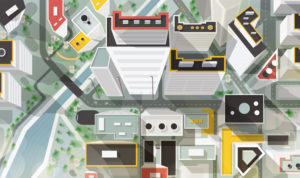Our last two articles (here and here) explored the scaling of Work-Study Practices (WSPs, a.k.a., deeper learning competencies) in New Hampshire, the growth of this education innovation in the state and the role of a statewide, nonprofit intermediary, the New Hampshire Learning Initiative (NHLI) as a scaling agent.
There is another driver of scale observed by JFF staff: a competency-based learning relationship management (LRM) platform hosted by Motivis Learning and customized with leadership from NHLI and input from educators involved in the state’s Performance Assessment for Competency-based Education (PACE) system.
Many educators are familiar with learning management systems (LMS) like Blackboard, Canvas and Google Classroom. These systems help support the online delivery and management of individual courses for instructors and learners. Like these other LMS’s, the Motivis Learning platform incorporates key functions such as content modules, grade books and assessment tools.
Because our scaling model is largely invitational and dependent on the spread of social networks that draw people into the work, NHLI was particularly interested in the platform’s ability to enhance social relationships and social learning into its design. This feature allowed NHLI to support teachers in districts across the state to jointly create performance tasks while keeping key competencies, content standards, and task development tools and resources in reach.
For New Hampshire’s WSP and PACE efforts, the platform allowed us to work beyond class and district boundaries to support the kinds of cross-site collaborations necessary to develop and calibrate performance assessments. The platform supports both a professional community of cross-district designers and provides a mechanism for state accountability and common task scoring.
NHLI worked in collaboration with Motivis to shape and maximize the platform’s key features to bring the state’s performance assessment task development processes online. In particular, NHLI customized platform components to meet the unique needs of early adopters, innovators, and those wondering if WSPs were right for their classroom or school. In doing so, they prioritized the following components:
Windows – If interventions are to scale, it is helpful for agents of scale to be able to see into other contexts and across barriers or boundaries.
Having a window into these new places helps to understand what might translate and what might not. NHLI has worked to ensure that the learning platform’s assets such as competencies, content standards and tasks across all disciplines are available to any task developer in the system. This allows performance task teams to see what others are doing and bring those examples into their work. For the WSPs, this means that while six performance tasks were being developed with specific instruction in the WSP of self-direction, other task developers had access to the assessment rubrics for all four WSPs. As a result, 51 tasks have included scoring on at least one WSP, demonstrating the demand for such tools and hinting at the potential to rapidly scale their use.
Bridges – In any social system, it is important that there are individuals, organizations or features that allow ideas and practice to move from one part of the system to another.
These bridges are critical to both diffusion and scale. Using the state-wide online platform for PACE task development and calibration is structured as an open community. This allows teams of educators to work asynchronously and remotely, across their classroom and district boundaries. This bridge function allows for easier collaborative teamwork while allowing developers to see how their work fits into a larger community. This ability to span boundaries bodes well for the diffusion of innovation by allowing educators to access and try new tools and approaches.
Roadmaps – A clear vision or destination, along with guardrails or guiding criteria, can help scale efforts when there is a diversity of contexts and conditions.
NHLI used the Motivis platform to ensure that the online task developers worked from common structures and processes that help bind the PACE system together. These design elements support state-wide content standards, established content competencies, task development processes and calibration activities. 
The scaling of New Hampshire’s WSPs is just beginning, but in a brief two years, a good deal of progress has been made.
The PACE accountability system’s backbone is now the social learning technology platform which is regularly enhanced by teachers and leaders around the state and the expertise of NHLI. In it, teachers are creating learning environments that allow students to build deeper learning skills and overcome the isolation that so often plagues the profession. If you’d like to find out more about the work on scaling deeper learning in New Hampshire, visit our project Building Essential Skills Today (BEST) for the Future on the web at http://www.best-future.org.
Felicia M. Sullivan, Ph.D. is an Associate Research Director at JFF (Jobs for the Future). Her research interests include human development and organizational learning towards system change as well as the effective translation of research and evidence through cross-sector collaboration. She is currently research deeper learning outcomes for high school students and the diffusion of innovation and scaled impact. Email: fsullivan@jff.org Twitter: @feliciasullivan.
